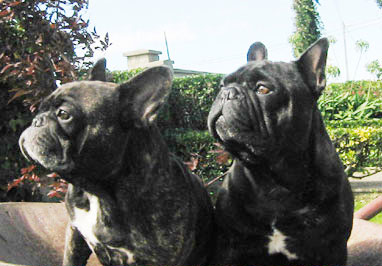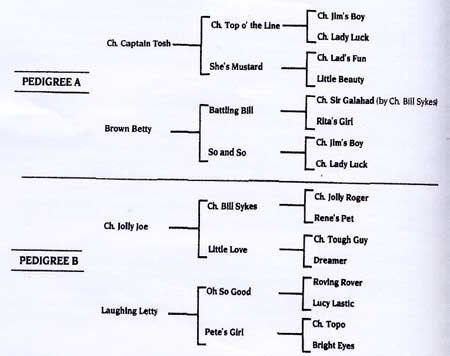
I am regularly asked how to read a pedigree. "What does it all mean... Pedigrees are just a jumble of names to me... I don´t know whether it´s a good pedigree or not". Of course, on the surface a pedigree is just a list of names, and before being able to interpret that list into knowledge which will assist you when planning a mating, you first need to know something about your breed. For instance if I were to study a pedigree in a breed which I didn´t know, it could appear to be well balanced and carefully line-bred to a particular dog or pair of dogs, but as I know nothing about the qualities of that dog or pair, I won´t know the significance of the careful line-breeding.
Double up
The matings which have given our kennel the most success have benn aunt to nephew,
uncle to niece, grand-parents to grand-children and occasionally cousin to
cousin. In the early days in my breed I studied pedigrees of the most successful
kennel and found the winners had been line-bred to a particular pair. By luck
(as I did not have enough knowledge in those days to have bought a bitch on the
strength of the pedigree) I found this pair doubled up in the pedigree of my
foundation bitch. With the help of the owner of that line, I too used this pair
as the foundation on which to build my own line. That line, nearly 40 years on,
has produced between thirty and forty champions for us, apart from the many
other kennels which have that breeding as the foundation of their own success.
In telling you this I am not claiming my own cleverness, merely my luck in
starting with the right line, followed by my realisation that I need the
experience of the originator of that line to get me off the ground, so to speak.
Significance
Line-breeding itself is usually carried on within
the first three generations, but you need knowledge back to at least the fourth
and the fifth generations to see the significance of a line-bred pedigree. So
first look for the relationship of the sires and dams in the first three
generations. Then trace back any parent, grandparent or great-grandparent which
is repeated within the three generations and notice which, if any, of their
ancestors have been line-bred to build up a pedigree based on a good dog, bitch
or pair.
As you became more experienced at reading pedigrees you will slowly
learn the significance of the relationships in each generation, and here is
where you need to know something about those repeated names. Have they produced
a successful line which has consistently won over the generations? Are they
behind any other successful kennel? If so, the more they have been successfully
used over several lines, the more important they are for good and bad, let me
add, but I will come to that later.The following pedigrees will illustrate this.
They are of two well-known champion bitches, but the names have obviously been
changed.

In looks, B was the
better bitch, easily gaining her championship title. While A was a worthy
champion, she was not as outstanding as B. A was a first rate a brood bitch,
producing Group and Reserve Group winners plus a top stud dog, and through her
offspring she is behind most of the top winners in her breed today. Although B
produced two champions when mated back to the best line in her pedigree through
Ch. Bill Sykes, her descendants to the present day are mediocre and only
occasionally produce an indifferent champion.
If you study the structure of
their pedigrees you will see why. A was the result of careful line-breeding over
many generations and was produced by a full cousin mating to the breeding which
produced Ch Top o' the Line, one of the most outstanding dogs both in looks and
at stud which the breed has had.
Bitch B on the other hand was the result of
an outcross with only one really good line through Ch. Bill Sykes who, although
a mediocre champion himself, was the result of a careful line-breeding and
became an outstanding stud dog. Actually, Ch Bill Sykes was one of the two dogs
to whom bitch A had been line-bred. The other three quarters of bitch B's
pedigree mainly consists of indifferent dogs and bitches, badly out crossed. If
the fact that her qualities had come through Ch. Bill Sykes had been recognised
and careful line-breeding had been carried out to him, her descendants too may
have eventually reached the quality of bitch A's descendants. Yet apart from one
mating, she was bred to the wrong lines in her pedigree.
Future offspring
You can look at the pedigree of your foundation bitch
and because you do not as yet know much about the breed, think it well planned.
But as the qualities of the common ancestors are unknown to you, you won´t know
how they will be likely to affect future offspring. A champion repeated over and
over covering several generations does not necessarily mean it is a good
pedigree. It depends on the quality and breeding of that champion.
You see, a
champion can be an outstanding specimen of its breed, or it can be one which has
been lucky to win three CCs. The outstanding champion may be a lucky chance bred
from poor ancestors. This type of dog or bitch is less likely to produce winners
and so needs to be treated with caution, searching for the dog or dogs from
which it has inherited its qualities and then breeding to them, ignoring the
rest of the pedigree when making breeding plans. Of course you can´t ignore the
rest altogether as their mediocrity will keep coming out. If you wish to
continue with such a dubious line, you must keep breeding back-all the time- to
the quality ancestors.
The non-champion ancestors who keep recurring are
important too, but so often new breeders only look at the well known names. They
will have points you will need to understand if you are to take advantage of the
qualities they appear to be able to pass along the generations.
I you are
lucky enough to start with a bitch who is carefully bred to quality stock,
things should be less difficult for you. But don´t try to go it alone too early.
Until you understand all the dogs and bitches in her pedigree and the reason
they have been mated in that way, you are most likely to do all the wrong things
and bring out the bad points rather than the good in the line. Learn all you can
about her pedigree from her breeder, as that is the only person who really knows
about it. Every time a puzzle crops up, go and talk to him or her. Every line
has its problems as well as its successes and only those who have successfully
used a line for several generations really know about them, and where and how
they are likely to crop up.
Turning your back
When you first come across problems in a line,
don´t throw up your hands in horror and blame everyone who has ever had
anything to do with that line. Stop and think, and most of all, keep those
problems in proportion. I repeat, every line in every breed has its problems.
Turning your back on them and pretending they´re not there won´t work. I´ve seen
people who have try it! Vociferously condemning the breeders of that line won´t
work either, as they will clam up and leave you to get on as best you can. Look
at it logically. What else can they do? If you are behaving negatively, they
can´t give you positive help.
When you come across a problem, accept it as a
challenger... Something to be coped with...something you will have to learn to
control. Or get out of that line and that breed and leave them to more
level-headed breeders. If you quietly go about the business of learning about
the problem, particularly as it concerns your breed and your line, you will find
other breeders more than willing to advise you and discuss your experiences with
you, comparing them with their own. Believe me, I have seen more than one
problem improved in my own breed by breeders quietly getting together to cope
with knowledge and experience within the breed itself.
Remember, it´s human
nature to talk more about troubles than give praise for success. Isn´t that what
our daily papers are mainly about? While you are busy knocking the successful
breeders you are building a wall between you and them, and you won´t be able to
talk through a wall; it has been my experience that no matter how they appear on
the surface, the majority of my fellow breeders, deep down, only want the best
for their breed and will gladly help others if they go about seeking help in the
right way.
To sum up, interpreting a pedigree means you need to know about
line-breding so that you can understand the significance of the names from one
generation to another, and have knowledge of your breed so that you know the
show and breeding potential of each of the repeated names.
Understanding the
value of a pedigree is a vast subject and I have only touched on the fringe. But
I hope it has given you enough to at least start a successful study of the
breeding of your own foundation bitch... And other pedigrees in the breed too of
course, as you will need to investigate the breeding of the dogs you are
considering for her as a mate.
Published in: "Dogs Monthly". March 1986. UK
|